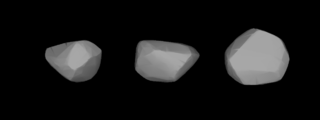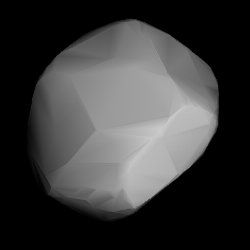
111 Ate is a main-belt asteroid discovered by the German-American astronomer C. H. F. Peters on August 14, 1870, and named after Ate, the goddess of mischief and destruction in Greek mythology. In the Tholen classification system, it is categorized as a carbonaceous C-type asteroid, while the Bus asteroid taxonomy system lists it as an Ch asteroid.

128 Nemesis is a large 180 km main-belt asteroid, of carbonaceous composition. It rotates rather slowly, taking about 78 hours to complete one rotation. Nemesis is the largest member of the Nemesian asteroid family bearing its name. It was discovered by J. C. Watson on 25 November 1872, and named after Nemesis, the goddess of retribution in Greek mythology.

152 Atala is a large main belt asteroid that was discovered by brothers Paul Henry and Prosper Henry on 2 November 1875, but the discovery was credited to Paul. It is a type D asteroid, meaning that it is composed of carbon, organic rich silicates and possibly water ice.

165 Loreley is a main-belt asteroid that was discovered by C. H. F. Peters on August 9, 1876, in Clinton, New York and named after the Lorelei, a figure in German folklore.

192 Nausikaa is a large main-belt S-type asteroid. It was discovered by Johann Palisa on February 17, 1879, at Pula, then in Austria, now in Croatia. The name derives from Nausicaä, a princess in Homer's Odyssey.

194 Prokne is a main-belt asteroid that was discovered by German-American astronomer C. H. F. Peters on March 21, 1879, in Clinton, New York, and named after Procne, the sister of Philomela in Greek mythology. Stellar occultations by Prokne have been observed twice, in 1984 from Italy and again in 1999 from Iowa.

208 Lacrimosa is a main-belt asteroid that was discovered by Austrian astronomer Johann Palisa on October 21, 1879, in Pola. The name derives from Our Lady of Sorrows, a title given to Mary, the mother of Jesus. It is orbiting the Sun at a distance of 2.89320 AU with a period of 4.92 yr and an eccentricity (ovalness) of 0.013. The orbital plane is inclined at an angle of 1.7° to the plane of the ecliptic.

211 Isolda is a very large, dark main-belt asteroid. It is classified as a C-type asteroid and is probably composed of primitive carbonaceous material. The spectra of the asteroid displays evidence of aqueous alteration.

230 Athamantis is a fairly large main-belt asteroid that was discovered by the German-Austrian astronomer K. de Ball on September 3, 1882, in Bothkamp. It was his only asteroid discovery. The asteroid was named after Athamantis, daughter of Athamas the mythical Greek king of Orchomenus.

238 Hypatia is a large main-belt asteroid that was discovered by Russian astronomer Viktor Knorre on July 1, 1884, in Berlin. It was the third of his four asteroid discoveries. The name was given in honour of philosopher Hypatia of Alexandria. Based upon the spectrum, it is classified as a C-type asteroid and is probably composed of primitive carbonaceous material. Like many asteroids of this type, its surface is very dark in colour.

308 Polyxo is a main-belt asteroid that was discovered by A. Borrelly on 31 March 1891, in Marseilles. It is orbiting the Sun at a distance of 2.75 AU with a low orbital eccentricity (ovalness) of 0.04 and a period of 4.56 yr. The orbital plane is tilted at an angle of 4.36° to the plane of the ecliptic.

350 Ornamenta is a relatively large main-belt asteroid, measuring 118 km in diameter. It is classified as a C-type asteroid and is probably composed of carbonaceous material.

386 Siegena is a very large main-belt asteroid. It is classified as a C-type asteroid and is probably composed of primitive carbonaceous material.
444 Gyptis is a main-belt asteroid that was discovered by J. Coggia on March 31, 1899, in Marseilles. It is classified as a C-type asteroid and is probably composed of carbonaceous material. The spectra of the asteroid displays evidence of aqueous alteration.
488 Kreusa is a C-type asteroid orbiting the Sun in the asteroid belt, with the type indicating a surface with a low albedo and high carbonaceous content. The spectra of the asteroid displays evidence of aqueous alteration.

505 Cava is a minor planet orbiting the Sun.
758 Mancunia is a minor planet orbiting the Sun. It was discovered in 1912 from Johannesburg by H. E. Wood, a Mancunian. This object is orbiting at a distance of 3.19 AU with a period of 5.70 years and an eccentricity (ovalness) of 0.15. The orbital plane is inclined at an angle of 5.61° to the plane of the ecliptic.
757 Portlandia is a main-belt asteroid 32 km in diameter. It was discovered on 30 September 1908 from Taunton, Massachusetts by the amateur American astronomer Joel E. Metcalf. The asteroid was named for the city of Portland, Maine, where Hastings was a church minister at the time. In November 2015, amateur astronomers captured it with images of comet 67P/Churyumov–Gerasimenko. Portlandia came to opposition in March 2016 at apparent magnitude 13.2.
790 Pretoria is a minor planet orbiting the Sun that was discovered by English astronomer Harry Edwin Wood on January 16, 1912. It is a member of the Cybele group located beyond the core of the main belt and named after Pretoria, the capital city of South Africa.
914 Palisana, provisional designation 1919 FN, is a Phocaean asteroid from the inner regions of the asteroid belt, approximately 77 kilometers in diameter. It was discovered by German astronomer Max Wolf at Heidelberg Observatory on 4 July 1919.














